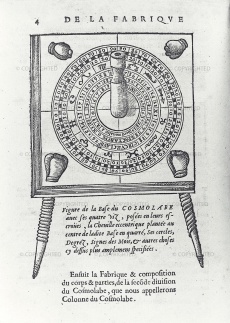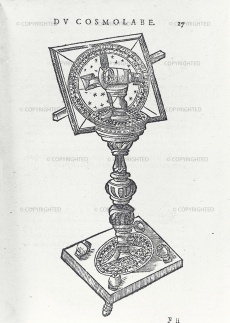Cosmolabe
From Inventions
| Line 1: | Line 1: | ||
{{Template invention | {{Template invention | ||
| - | |nome= | + | |nome= |
| + | Name coined by the inventor (in French, "cosmolabe") as a variant of astrolabe (from the Greek "kosmos"=world/universe and "lambánō"=that which takes/comprises). | ||
|inventore= Jacques Besson | |inventore= Jacques Besson | ||
| Line 7: | Line 8: | ||
|data= 1567 | |data= 1567 | ||
| - | |descrizione= | + | |descrizione= |
| + | Instrument invented and described by Jacques Besson (1567), having features similar to the vertical compass, the [[Geometric Planisphere | geometric planisphere]], and Leonardo's [[Folding Square | folding square]]. The two goniometric circles (horizontal and vertical) were used for land surveying and compiling the relevant corographic charts. The folding square was used to measure heights and to plot points, thanks to a stylus inserted in the joint, for compiling the corographic charts. The author also describes how the instrument can be used for drawing a map of the sky in perspective and for the anamorphic deformation of images: "En perspective scavoir par le Cosmolabe representer et pourtraire toutes choses qui se presentent à la veüe, ainsy qu'elles peuvent apparoistre dans toutes positions et especes de Miroers" (In perspective one can by the Cosmolabe represent and portray everything that appears to the view, as it can appear in all positions and all kinds of mirrors"] (III, IV, 271). | ||
|componenti= | |componenti= | ||
Revision as of 12:51, 13 November 2009
Name coined by the inventor (in French, "cosmolabe") as a variant of astrolabe (from the Greek "kosmos"=world/universe and "lambánō"=that which takes/comprises).
Contents |
Inventor
Jacques Besson
Historic Period
1567
Description
Instrument invented and described by Jacques Besson (1567), having features similar to the vertical compass, the geometric planisphere, and Leonardo's folding square. The two goniometric circles (horizontal and vertical) were used for land surveying and compiling the relevant corographic charts. The folding square was used to measure heights and to plot points, thanks to a stylus inserted in the joint, for compiling the corographic charts. The author also describes how the instrument can be used for drawing a map of the sky in perspective and for the anamorphic deformation of images: "En perspective scavoir par le Cosmolabe representer et pourtraire toutes choses qui se presentent à la veüe, ainsy qu'elles peuvent apparoistre dans toutes positions et especes de Miroers" (In perspective one can by the Cosmolabe represent and portray everything that appears to the view, as it can appear in all positions and all kinds of mirrors"] (III, IV, 271).
Bibliographical Resources
Besson, Jacques. Le cosmolabe, ou Instrument universel concernant toutes observations qui se peuvent faire par les sciences mathematiques, tant au ciel, en la terre, comme en la mer, de l'invention de m. Iaques Besson... , A Paris, par Ph.G. de Rouille, 1567.
Besson, Jacques. Le cosmographe instrument adioinct en la superieure partieu du cosmolabe au lieu de l'atlas.Paris, 1569, p. 300, 321.
Images
Author of the entry: Filippo Camerota



